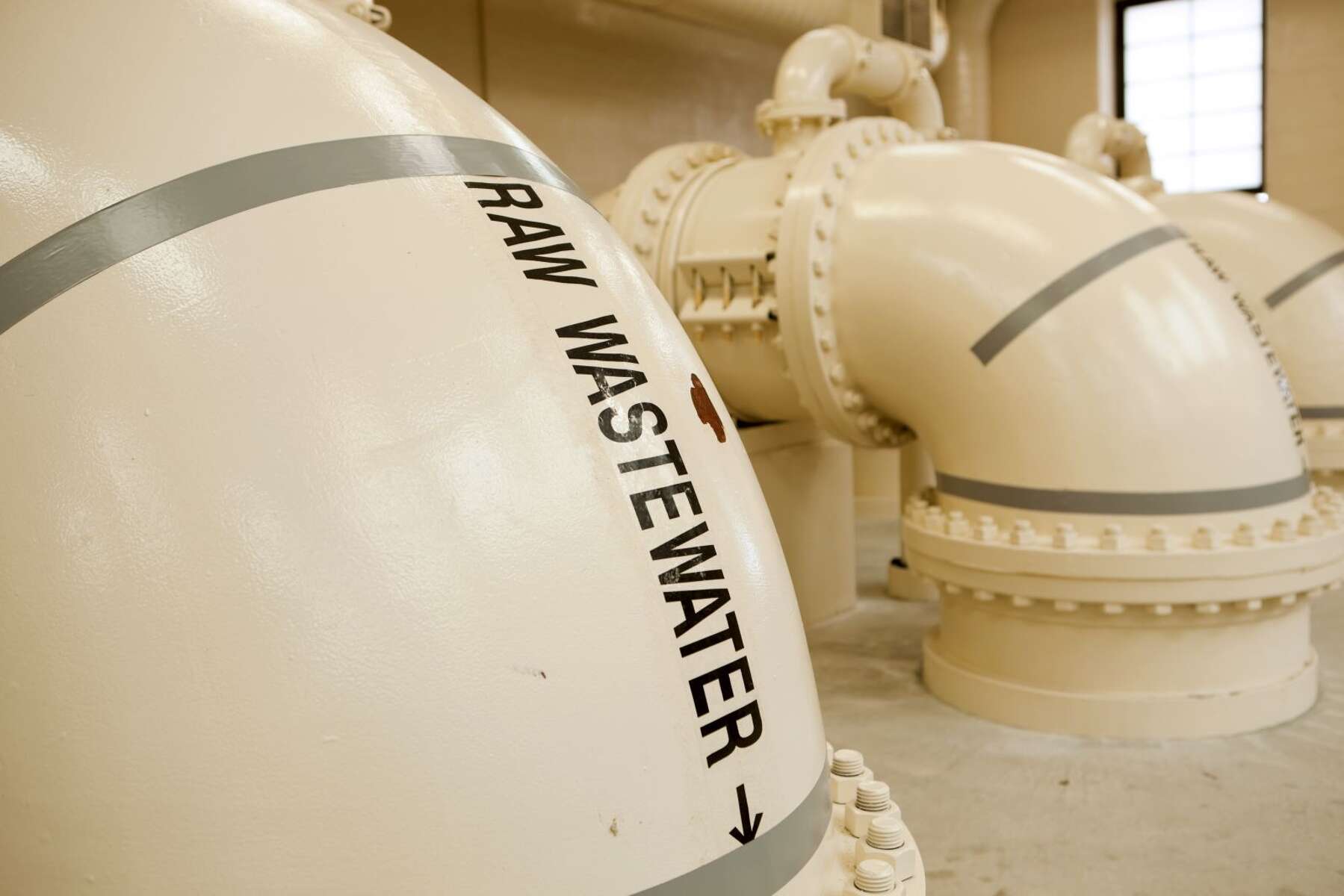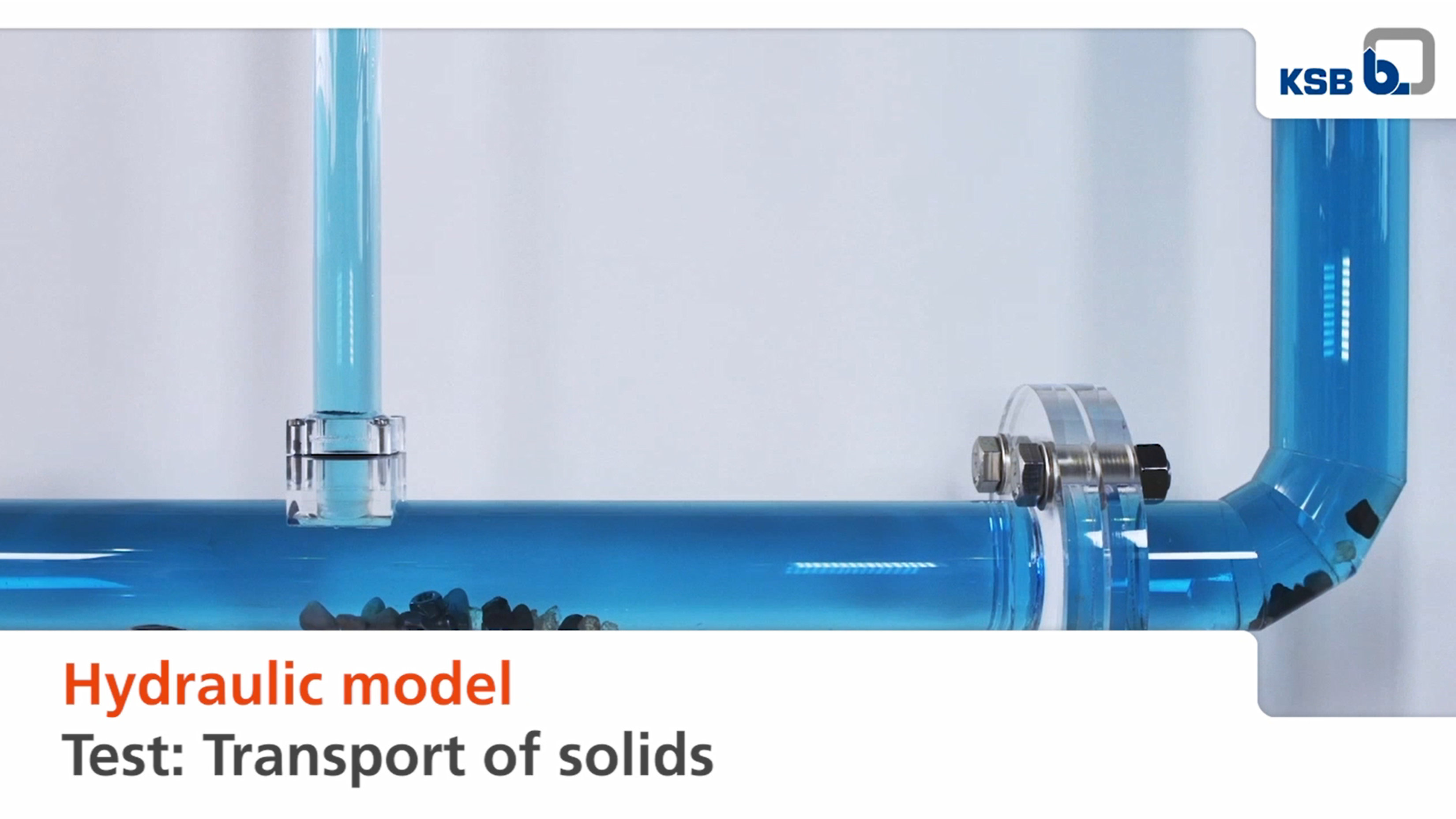
Hydraulic model testing: Solids transport in waste water pipes
Many waste waters contain solids such as fibres, sand, grit, stones, or organic contaminants. To make sure that these are also transported safely through the waste water pipes, the flow velocity in particular must be right. KSB has joined forces with the Technical University of Berlin to conduct a comprehensive model test to determine which flow velocities are ideal for which solids, and how they can be specifically influenced. Read on to find out more.
Many waste waters contain solids such as fibres, sand, grit, stones, or organic contaminants. To make sure that these are also transported safely through the waste water pipes, the flow velocity in particular must be right. KSB has joined forces with the Technical University of Berlin to conduct a comprehensive model test to determine which flow velocities are ideal for which solids, and how they can be specifically influenced. Read on to find out more.
KSB and the Technical University of Berlin carry out comprehensive investigations into the transport of solids in waste water pipes
Solids in waste water are a problem for many plant operators. These solids depositing in the piping can lead to considerable impairments in the transport capacity of the same and thus to generally more inefficient processes within a plant or system. Benching angles make an important contribution to ensuring that even fluids with a high solids content are transported reliably. But these structural measures only play a minor role compared with the most important factor in the transport of liquids: flow velocity. And special attention must be paid to this. This is because it is important to find exactly the right balance between deposits at too low a velocity and excessive friction losses at too high a velocity.
In order to answer the question regarding the optimum flow rate, KSB has begun comprehensive model testing in cooperation with the Technical University of Berlin (TU Berlin) on the entrainment of waste water components. Model testing was aimed at determining the influence of sediment type and size on the transport of sediment, as well as the necessary minimum velocities for waste water transport.
One thing is certain: A specific minimum flow velocity is always required to transport all solids away with the waste water.

The optimum minimum flow velocity for solids transport in waste water pipes
For the Solids Transport model testing, KSB has joined forces with the TU Berlin to investigate in greater detail the behaviour of various solids at different flow rates in pipes. The key element of the model test comprised a horizontal and a vertical pipe section. A pump in a water tank mounted at the back provided appropriate circulation of the fluid. The water was pumped back to the sump after the experiment was finished. Solids transported with the fluid were collected in a basket. The set-up was completed by gate valves and measuring equipment for setting the flow velocity.
Various solids typically found in waste water and of different densities, sizes and surfaces (e.g. stones, metal parts and glass splinters) were fed into the horizontal pipe via a feeder pipe. By opening the valve on the pump's discharge side, the flow velocity of the fluid was increased until the respective type of solid was transported by the fluid handled in the horizontal or vertical pipe section.
In the first part of the experiment, the behaviour of broken glass was examined at different flow velocities. The broken glass was introduced into the pipe and remained directly under the feeder pipe. The pump was then started up and the gate valve on the discharge side was slowly opened. The experiment started at a low flow velocity. At a flow velocity of 0.15 m/s, the solids did not move. It was then increased step by step. Above a flow velocity of approx. 0.4 m/s, the pieces of glass began to move. At a speed of about 0.5 m/s, the pieces of glass moved to the end of the horizontal pipe where it was ascending towards the vertical pipe. At about 0.7 m/s, the pieces of glass also moved upwards in the vertical tube and were transported though and out of the pipe.
In the second part of the experiment, the behaviour of round and smooth stones was examined at different flow velocities. Above a flow velocity of approx. 0.4 m/s, the stones started to move slightly. Above 0.45 m/s, the stones moved to the end of the horizontal pipe and remained in place where it became vertical. After the flow velocity was increased to 0.8 m/s, the stones then moved up the vertical pipe.
In the third part of the experiment, the behaviour of rough and angular stones under increasing flow velocity was investigated. At a flow velocity of 0.45 m/s, the first stones started to move. At about 0.5 m/s, the stones moved to the end of the horizontal pipe and remained in place where it became vertical. After the flow velocity was increased to 0.8 m/s, the rough and angular stones then moved up the vertical pipe.
In the fourth part of the experiment, the behaviour of small steel parts (bolts and nuts) at different flow velocities was investigated. At about 0.6 m/s, the first parts began to move. At a flow velocity of 0.9 m/s, all parts moved as far as the end of the horizontal pipe. At about 1.2 m/s, the first metal pieces moved upwards in the vertical pipe. Only at a flow velocity of 1.7 m/s were all other remaining metal parts also transported upwards in the vertical pipe.
In the fifth experiment part, the behaviour of a mixture of solids (consisting of stones, broken glass and metal parts) was investigated at different flow velocities. At a flow velocity of 0.4 m/s, the first solids started to move: Pieces of glass and stones detached themselves from the mixture. At about 0.45 m/s, broken glass and stones moved to the end of the horizontal pipe and remained at the bend to the vertical pipe section. At approx. 0.55 m/s, some parts of the broken glass were being transported up the vertical pipe. At about 0.7 m/s, all stones in the vertical tube moved upwards. At approx. 1.7 m/s, all metal parts remaining in the horizontal pipe were transported up the vertical pipe section.
Minimum flow velocities for the transport of solids in waste water pipes
Conclusion of the Solids Transport model test
Model testing conducted by KSB and the Technical University of Berlin has made it clear that the speed at which a particle settles depends, among other things, on its shape, size and density. Almost spherical gravel of a coarse grain size settles much faster than sand or organic fibres. For this purpose, different minimum flow velocities must be maintained for horizontal or vertical piping, depending on the diameter. In vertical pipes, higher flow velocities are required to transport the solids.
Model testing by KSB: Thinking small, building big
In general, KSB conducts model tests for an object or procedure whenever the measurement of original conditions is not technically or economically feasible. Experimental investigations enable KSB to discover new potential for increasing efficiency in pump systems.
The Solids Transport hydraulic model test was only one of many model tests carried out by KSB. Expand your specialist knowledge with the results of some of our other hydraulic model tests on topics such as gas pockets, benching or air intake.
Good to know: When planning, performing and evaluating model tests and transferring the results to the original-size machine and/or the original operating conditions, the affinity laws are observed and applied. Apart from maintaining geometric similarity, this involves considering changes in length due to elastic and thermal deformations, converting test results on the basis of affinity laws, observing fluid properties, and much more.
In other words, everything that allows a model test to optimise the daily operation of a pump system in real life.
Do you have any questions? Please contact us(opens in a new tab). We look forward to hearing from you.
Suitable products
Amarex KRT
Horizontal or vertical single-stage submersible motor pump in close-coupled design, with various next-generation impeller types, for wet or dry installation, stationary or transportable version, with energy-saving motor and models for use in potentially explosive atmospheres.
Sewatec
Volute casing pump for horizontal or vertical installation, with various next-generation impeller types, discharge flange to DIN and ANSI standards. Explosion-proof version available.